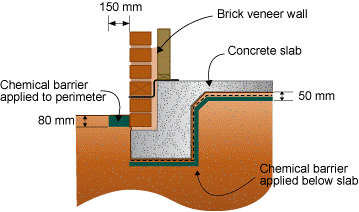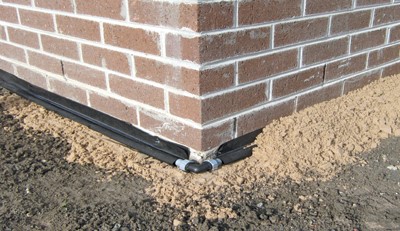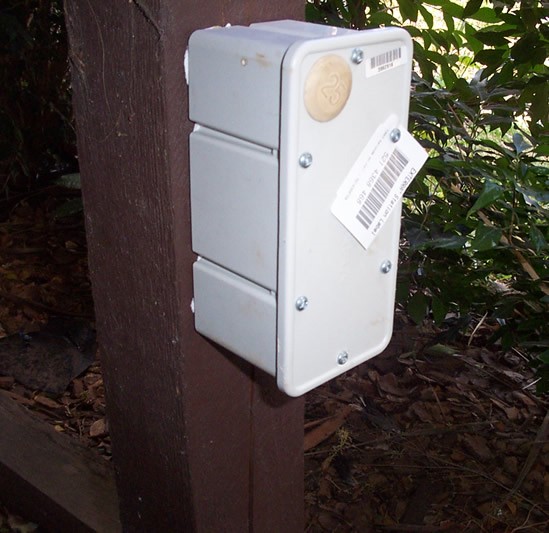Termite Management Control
Termite Control methods for termites can essentially be divided into two groups, prevention and treatment. Preventative measures are applied during the construction of new buildings and treatment is applied to pre-existing buildings.
There are different options that can be used in the control of termites, such as baiting and application of termiticides. The only ways of getting rid of termites completely are either through the use of chemicals or baiting. With baiting the chemical is applied in a designated, well-controlled manner.
Customers often ask about the installation of non-chemical physical barriers as a part of termite control. Unfortunately, this is only possible during construction of the building and canŌĆÖt be done in existing structures.
Pre-Construction Termite Control
Pre-Penetration termite Protection
┬ĀOne method of pre-penetration termite protection is through pipe penetration collars. These collars are available in various sizes and act as a physical barrier to stop attacking termites from entering a building through the pipes.
Termite Chemical Barrier
Many owners of new buildings prefer to ŌĆśbuild inŌĆÖ a termite treatment while the building is being erected. Therefore many new buildings are being protected against termite infestations by creating a termiticide-treated layer of soil surrounding and under the building. A chemical treatment barrier involves applying a liquid chemical to the soil, either under concrete flooring or around the entire perimeter of your property’s foundations. This solution provides a protective barrier around your property that prevents access to subterranean termites.
What you need to know?
* A chemical termite barrier will last around your property between 3ŌĆō5 years.
* The barrier must make contact with the soil around your home to be effective. This may require drilling unobtrusive holes in concrete or paving and for garden debris to be moved away from the propertyŌĆÖs perimeter.
* An annual termite inspection is required to ensure continued protection of your property and your warranty remains valid.

Termite Reticulation System
┬ĀA termite reticulation system is a perimeter- and under slab irrigation system. It allows for easy termiticide application. The system is ideally suited for both pre and post-construction termite control. A specially designed pipe system is installed around the external perimeter of a new construction. It is often also installed under the slab of the construction. The pipe is then pumped with a termiticide and through controlled weep holes, the chemical drips out and impregnates the soil to form a protection barrier against termites. Over a number of years, the system can become less effective, so it is recommended that it be replenished/recharged through the fill-up points of the pipe system every 2 to 3 years.
Post Construction Termite Control
Termidor Termite Dust Treatment
Because of ineffective termite treatments used on termite colonies during previous treatments, it is possible that termites may be present in a house with no connection to the exterior. This usually happens because of a previous treatment conducted with older termite control products that are repellent, thus trapping them inside with no choice but to feed solely on the house timbers. This was really a case of making a bad situation worse.
Also, leaking plumbing inside the house can create conditions where the termites do not need to return to the soil as their moisture source. What makes it worse is that under these conditions, no liquid treatment will be effective. The moisture will dilute the liquid treatment, rendering it ineffective. In these cases we use Termidor termite dust.
Termidor dust is either applied directly on the termites or gets applied to any places there are evidence of termite activity such as in the interior or exterior of the building. It is also used in yards, trees or fences. Once the Termidor dust is applied, the affected termites become carriers of the dust. They carry the dust particles on their bodies, spreading the dust to other termites within the entire colony.
People need to understand that eradication of one termite colony with Termidor Dust doesnŌĆÖt guarantee protection from a future attack by other colonies in the area. Therefore, to ensure future termite control, the application of a chemical barrier or termite baiting and monitoring system is recommended.
The Australian Standard for termite control states that an initial remedial treatment such as dusting be conducted before applying the longer lasting chemical treatment, thus creating a chemically treated zone
Termite Chemical Barriers
┬ĀA termiticide such as Termidor is applied as a continuous chemical soil zone around the external walls, footings and sub floor areas of a building. The termiticide is applied either by creating a trench or by injecting it into the ground. Because termites often use footpaths and patios to gain entry into a building, the termiticide can also be injected through these.
Termidor is non-repellent to termites. This means that they cannot see or smell the product and therefore will not avoid the treated area. As a result, the termites continue to randomly forage through the soil until they encounter Termidor. Once this happens and they get a lethal dose, the whole termite colony will soon be eradicated.
The way Termidor works is by moving only a small distance outward from the site of application before binding tightly to organic material in the soil. This means that Termidor concentration decreases with increasing distance from the site. The termites will come into contact with the lowest concentration of Termidor first. Some of them will survive and end up transferring the termiticide to others in the colony through normal feeding and grooming. This unique Transfer EffectTM is devastating to other termites not directly exposed to the Termidor treated zone. It could wipe out the entire colony. If termites continue to tunnel into the treated soil where the Termidor concentration is higher, they will die more quickly. This makes Termidor very effective as it is two termite treatments in one.
┬ĀIn Ground Termite Monitoring & Baiting
┬ĀAustralian Pest Specialists monitoring service is an essential path to termite control and prevention. Unobtrusive termite bait stations are placed around the perimeter of your property to detect termites that are heading towards your home. Your Pest Prevention Termite Expert will routinely monitor these stations for termite activity and when detected, bait is added to your system.

What you need to know?
* Installation of in-ground monitoring and baiting stations may require holes to be created in concrete and paving.
* You will be provided with a Pest Control Service folder that will detail your monitoring and baiting program. Your Termite Expert will update this
folder with a service report at each visit, ensuring that you always have the important and up to day information at hand.
Termite Reticulation System
A termite reticulation system is a perimeter- and under slab irrigation system that infuses termiticide into the area where it is located. It allows for easy termiticide application. The system is ideally suited for both pre- and post-construction termite control.
A specially designed pipe system is installed around the external perimeter of a new construction. It is often also installed under the slab of the construction. The pipe is then pumped with a termiticide and through controlled weep holes, the chemical drips out and impregnates the soil to form a protection barrier against termites.
Over a number of years, the system can become less effective, so it is recommended that it be replenished/recharged through the fill up points of the pipe system every 2 to 3 years.

Above Ground Termite Baiting
If termite activity is found, an above ground baiting solution can be used. Above ground bait stations are placed on termite activity within the structure. The termites consume the bait and take it back to the nest, therefore infecting and eliminating the colony.
The bait inside the station is highly palatable to termites but non-toxic to pets and children.

What you need to know?
* The baiting stations are placed directly on the termite┬Ā activity. This may be within your property or in the garden.
* It can take anywhere between 2-9 months for the baiting program to be complete, depending on your individual situation.

